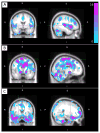Bladder Distension Increases Blood Flow in Pain Related Brain Structures in Subjects with Interstitial Cystitis
- PMID: 27018508
- PMCID: PMC5014638
- DOI: 10.1016/j.juro.2016.03.135
Bladder Distension Increases Blood Flow in Pain Related Brain Structures in Subjects with Interstitial Cystitis
Abstract
Purpose: In healthy control subjects certain brain regions of interest demonstrate increased regional cerebral blood flow in response to painful stimuli. We examined the effect of bladder distension on arterial spin label functional magnetic resonance imaging measures of regional cerebral blood flow in regions of interest in subjects with interstitial cystitis.
Materials and methods: A total of 11 female subjects with interstitial cystitis and 11 healthy controls underwent 3 brain perfusion scan studies using arterial spin label functional magnetic resonance imaging, including 1) with a full bladder, 2) with an empty bladder and 3) while experiencing heat pain. Regional cerebral blood flow was calculated using custom software and individual scans were spatially normalized to the MNI (Montreal Neurological Institute) template. Region of interest based, absolute regional cerebral blood flow was determined for each condition and for the within group/within subject regional cerebral blood flow distribution changes induced by each condition.
Results: Bladder distension was associated with robust increases in regional cerebral blood flow in subjects with interstitial cystitis. The increases were greater than those in healthy controls in multiple regions of interest, including the supplemental motor area (mainly Brodmann area 6), the motor and sensory cortex, the insula bilaterally, the hippocampal structures bilaterally, and the middle and posterior cingulate areas bilaterally. During heat pain healthy controls had more robust regional cerebral blood flow increases in the amygdala bilaterally. At baseline with an empty bladder there was lower regional cerebral blood flow in the insula, and the mid and posterior cingulate cortex bilaterally in subjects with interstitial cystitis.
Conclusions: Compared to healthy controls, subjects with interstitial cystitis have limited differences in regional cerebral blood flow in baseline (empty bladder) conditions as well as during heat pain. However, they had robust regional cerebral blood flow increases in the full bladder state in regions of interest typically associated with pain, emotion and/or motor control, indicating altered processing of bladder related sensations.
Keywords: brain; cerebrovascular circulation; cystitis, interstitial; pain; urinary bladder.
Copyright © 2016 American Urological Association Education and Research, Inc. Published by Elsevier Inc. All rights reserved.
Figures



Similar articles
-
Cerebral Perfusion and Sensory Testing Results Differ in Interstitial Cystitis/Bladder Pain Syndrome Patients with and without Fibromyalgia: A Site-Specific MAPP Network Study.J Pain Res. 2021 Dec 23;14:3887-3895. doi: 10.2147/JPR.S343695. eCollection 2021. J Pain Res. 2021. PMID: 34992450 Free PMC article.
-
Increased brain gray matter in the primary somatosensory cortex is associated with increased pain and mood disturbance in patients with interstitial cystitis/painful bladder syndrome.J Urol. 2015 Jan;193(1):131-7. doi: 10.1016/j.juro.2014.08.042. Epub 2014 Aug 14. J Urol. 2015. PMID: 25132239 Free PMC article.
-
Alterations in resting state oscillations and connectivity in sensory and motor networks in women with interstitial cystitis/painful bladder syndrome.J Urol. 2014 Sep;192(3):947-55. doi: 10.1016/j.juro.2014.03.093. Epub 2014 Mar 26. J Urol. 2014. PMID: 24681331 Free PMC article.
-
Phenotyping of interstitial cystitis/bladder pain syndrome.Int J Urol. 2019 Jun;26 Suppl 1:17-19. doi: 10.1111/iju.13969. Int J Urol. 2019. PMID: 31144756 Review.
-
Interstitial cystitis, bladder pain syndrome, hypersensitive bladder, and interstitial cystitis/bladder pain syndrome - clarification of definitions and relationships.Int J Urol. 2019 Jun;26 Suppl 1:20-24. doi: 10.1111/iju.13970. Int J Urol. 2019. PMID: 31144731 Review.
Cited by
-
Exercise modulates neuronal activation in the micturition circuit of chronically stressed rats: A multidisciplinary approach to the study of urologic chronic pelvic pain syndrome (MAPP) research network study.Physiol Behav. 2020 Mar 1;215:112796. doi: 10.1016/j.physbeh.2019.112796. Epub 2019 Dec 27. Physiol Behav. 2020. PMID: 31884113 Free PMC article.
-
Quantitative assessment of nonpelvic pressure pain sensitivity in urologic chronic pelvic pain syndrome: a MAPP Research Network study.Pain. 2019 Jun;160(6):1270-1280. doi: 10.1097/j.pain.0000000000001505. Pain. 2019. PMID: 31050659 Free PMC article.
-
Role of neurogenic inflammation in local communication in the visceral mucosa.Semin Immunopathol. 2018 May;40(3):261-279. doi: 10.1007/s00281-018-0674-0. Epub 2018 Mar 26. Semin Immunopathol. 2018. PMID: 29582112 Free PMC article. Review.
-
Divergent functions of the left and right central amygdala in visceral nociception.Pain. 2017 Apr;158(4):747-759. doi: 10.1097/j.pain.0000000000000830. Pain. 2017. PMID: 28225716 Free PMC article.
-
Relationships between brain metabolite levels, functional connectivity, and negative mood in urologic chronic pelvic pain syndrome patients compared to controls: A MAPP research network study.Neuroimage Clin. 2017 Nov 15;17:570-578. doi: 10.1016/j.nicl.2017.11.014. eCollection 2018. Neuroimage Clin. 2017. PMID: 29201643 Free PMC article.
References
-
- Athwal BS, Berkley KJ, Hussain I, et al. Brain responses to changes in bladder volume and urge to void in healthy men. Brain. 2001;124:369–377. - PubMed
-
- Blok BFM, Sturms LM, Holstege G. Brain activation during micturition in women. Brain. 1998;121:2033–2042. - PubMed
-
- Kuhtz-Buschbeck JP, Gilster R, van der Horst C, et al. Control of bladder sensations: an fMRI study of brain activity and effective connectivity. Neuroimage. 2009;47:18–27. - PubMed
-
- Griffiths D, Tadic SD. Bladder control, urgency and urge incontinence: evidence form functional brain imaging. Neurourology and Urodynamics. 2008;27:466–474. - PubMed
MeSH terms
Grants and funding
LinkOut - more resources
Full Text Sources
Other Literature Sources
Medical

